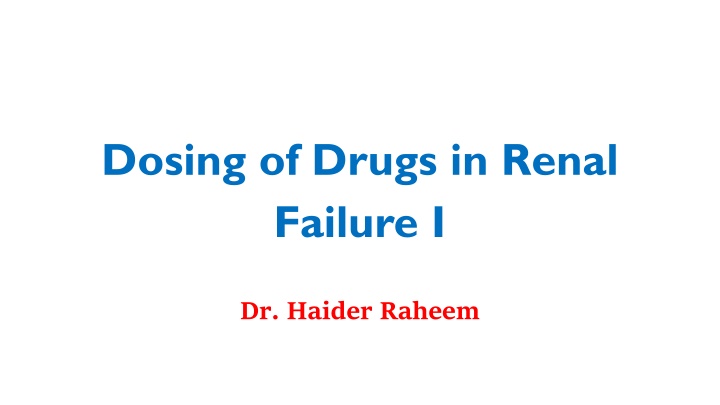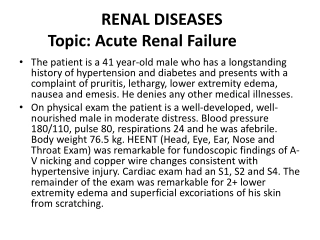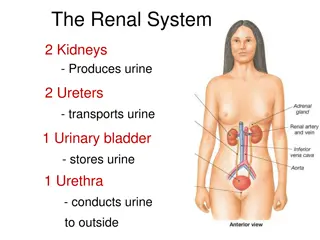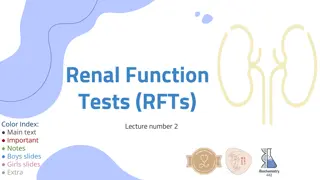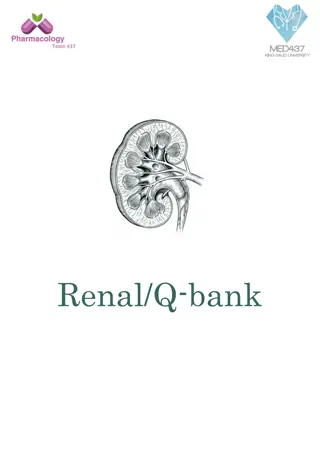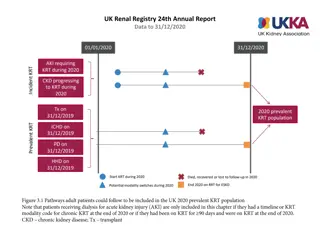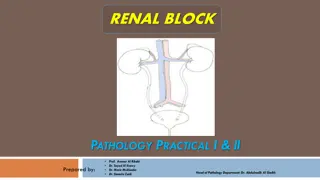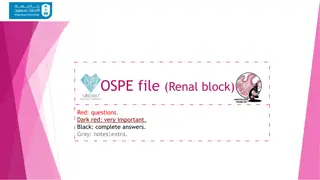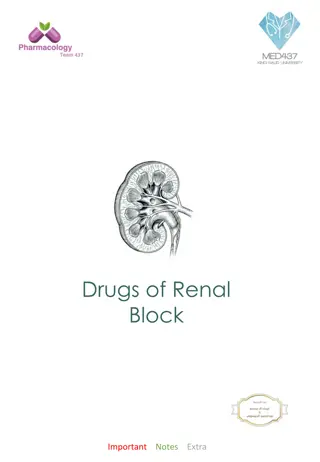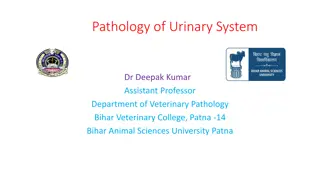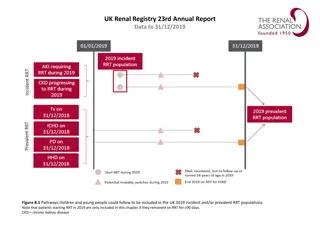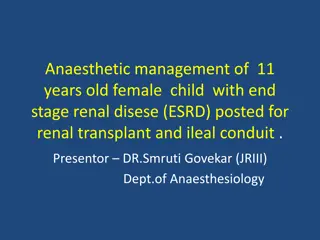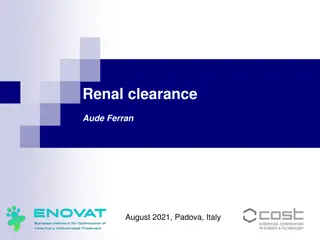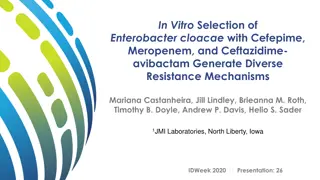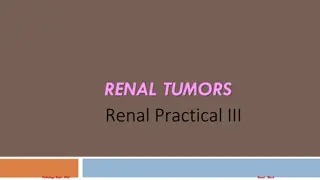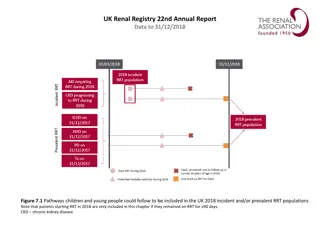Ceftazidime Dosage Modification in Renal Failure Cases
Ceftazidime dosage adjustments are crucial in patients with renal impairment to prevent toxicity or suboptimal treatment. Factors like renal function, drug elimination route, and therapeutic window must be considered. Proper dosing ensures effective treatment while avoiding adverse effects in patients like G.G., who presents with systemic lupus erythematosus and acute renal failure.
Download Presentation

Please find below an Image/Link to download the presentation.
The content on the website is provided AS IS for your information and personal use only. It may not be sold, licensed, or shared on other websites without obtaining consent from the author.If you encounter any issues during the download, it is possible that the publisher has removed the file from their server.
You are allowed to download the files provided on this website for personal or commercial use, subject to the condition that they are used lawfully. All files are the property of their respective owners.
The content on the website is provided AS IS for your information and personal use only. It may not be sold, licensed, or shared on other websites without obtaining consent from the author.
E N D
Presentation Transcript
Dosing of Drugs in Renal Failure I Dr. Haider Raheem
Ceftazidime Dosage Modification: Factors to Consider G.G., a 31-year-old, 70-kg woman with a 3-year history of systemic lupus erythematosus, presents to the emergency department (ED) with a 5-day history of fatigue, weakness, and nausea as well as worsening of her facial rash and a fever of 40 C. Her systemic lupus erythematosus had been moderately controlled until this acute flare. Her admission laboratory workup now reveals the following pertinent values: Potassium (K), 6.0 mEq/L Sodium (Na), 142 mEq/L Serum creatinine (SCr), 3.4 mg/dL Blood urea nitrogen (BUN), 38 mg/dL
Ceftazidime Dosage Modification: Factors to Consider Complete blood count reveals a hematocrit of 32% and a hemoglobin of 9.2 g/dL. The platelet count is 50,000/ L, and her erythrocyte sedimentation rate is 35 mm/hour. Physical examination is significant for a blood pressure of 136/92 mm Hg and 2+ pedal edema. Prednisone is started at a dose of 1.5 mg/kg/day. Two weeks into her hospital course, G.G. s condition worsens and signs of sepsis develop. Pseudomonas aeruginosa is cultured from her urine. Therapy with ceftazidime is initiated at a dose of 1 g every 8 hours, a dose commonly used for patients with good renal function. Considering that G.G. s renal function has remained stable and that she has an estimated CrCl of 27 mL/minute, what factors should be considered before modifying her dose? What would be an appropriate dose of ceftazidime for G.G.?
Ceftazidime Before modifying the dose of any drug, its route of elimination should be established. As a general rule, the degree to which renal impairment affects elimination depends on the percentage of unchanged drug that is excreted by the kidney. Thus, the elimination of most drugs that are primarily cleared by the kidneys will be decreased in the setting of renal impairment. For many drugs dependent on the kidney for elimination, relationships between some measurement of renal function (e.g., CrCl) and some parameter of drug elimination (e.g., plasma clearance or half-life) have been established to help clinicians determine the appropriate dosing modifications in patients with renal disease.
Ceftazidime In contrast, the clearance of drugs that are eliminated primarily by nonrenal mechanisms (e.g., hepatic metabolism) is not altered significantly in patients with renal disease. However, some drugs have water-soluble metabolites that have either pharmacologic activity or potential toxicity and that may accumulate with renal dysfunction, warranting dosage adjustment or avoidance of the drug entirely (e.g., meperidine).
Ceftazidime Another important factor to consider is the therapeutic window for a given drug, i.e., the range of drug concentrations thought to be most effective. Drug concentrations below this range are usually subtherapeutic, whereas concentrations above this range can lead to a greater incidence of adverse effects. For drugs with a wide therapeutic window, the difference between toxic and therapeutic concentrations is large. Although many drugs that are cleared primarily by the kidney may require dosing modifications in patients with renal dysfunction, aggressive dose reduction may not be necessary for drugs with a large therapeutic window, particularly if the adverse effects of the drug (e.g., fluconazole) are relatively mild. This is in contrast to drugs (e.g., aminoglycosides, vancomycin, or foscarnet) that are eliminated primarily by the kidney and have narrow therapeutic windows.
Ceftazidime Ceftazidime is a cephalosporin that has excellent activity against most strains of Pseudomonas species. As with most cephalosporins, ceftazidime primarily is cleared by the kidneys, with little nonrenal or hepatic elimination. The correlation ceftazidime and CrCl in mL/minute is represented by the following equation: Clceftaz(mL/minute) = (0.95) (CrCl) + 6.59 between the clearance of
Ceftazidime The clearance of ceftazidime in G.G. is estimated to be 32 mL/minute compared with an average normal clearance of approximately 100 mL/minute. Because her drug clearance is approximately one-third of normal, she would require about one-third of the normal daily dose (i.e., 1 g every 24 hours). As with other cephalosporins, ceftazidime has a large therapeutic window. Failure to reduce the dose from a normal dose of 1 g every 8 hours, although likely safe, might lead to accumulation of ceftazidime, predisposing G.G. to seizures and other adverse effects associated with toxic -lactam antibiotic plasma levels.
Aminoglycosides G.G. s medical team decides that the addition of an aminoglycoside antibiotic is necessary to treat her infection. Considering that her renal function has remained stable, how should gentamicin be dosed in G.G.? Is it best to alter the dose or the dosing interval for this drug?
Aminoglycosides Alteration of Dose versus Dosing Interval The aminoglycosides (e.g., tobramycin, gentamicin, amikacin) are effective in the treatment of serious systemic infections caused by gram- negative organisms such as Pseudomonas species. cephalosporins and penicillins, however, the aminoglycosides have a relatively narrow therapeutic window. principles, a dose regimen can be designed to produce specific peak and trough serum concentrations. Unlike the Using pharmacokinetic
Aminoglycosides Alteration of Dose versus Dosing Interval Peak serum concentrations (Cppeak) (e.g., gentamicin or tobramycin 5 8 mg/L) correlate best with therapeutic efficacy, whereas toxicity tends to correlate with elevated trough levels (Cptrough), which reflects prolonged exposure to high drug concentrations. To minimize the risk of toxicity, trough levels of less than 2 mg/L should be maintained. In patients with normal renal function, these target serum aminoglycoside concentrations are usually obtained after standard doses (e.g., 1.5 mg/kg) administered every 8 hours. Peak and trough levels are typically measured once steady state is achieved, which is typically within 24 hours.
Aminoglycosides Many clinicians now use once-daily dosing of the aminoglycosides (e.g., 5 mg/kg every 24 hours) for patients with normal renal function in an attempt to minimize aminoglycoside nephrotoxicity. The rationale for this regimen is based on the aminoglycosides concentration-dependent killing and postantibiotic effect. This approach is not recommended for patients with advanced renal impairment. When once-daily dosing is used, peak concentrations are less helpful; however, trough concentrations should be monitored with a target of being below the limit of analytic detection (<1 mg/L). accumulation and
Aminoglycosides Aminoglycosides are almost completely eliminated by the kidneys; thus, the clearance of these drugs essentially is equal to the glomerular filtration rate (GFR). The pharmacokinetic properties of gentamicin and tobramycin are similar. A close correlation also exists between CrCl (a surrogate for GFR) and gentamicin total body clearance. As renal function deteriorates, aminoglycoside doses must be modified to achieve the desired peak and trough plasma concentrations. Failure to appropriately adjust the dosage insufficiency can lead to high drug plasma levels that can result in ototoxicity and nephrotoxicity. of aminoglycosides in renal
Aminoglycosides In many cases, the aminoglycoside dose can be modified by extending the dosing interval rather than simply reducing the dose. This permits maintenance of adequate peak plasma concentrations to ensure efficacy, while allowing for sufficient elimination between doses to produce trough levels less than 2 mg/L. The advantages and disadvantages of adjusting the dosing interval versus reducing the dose are summarized in Table 8-1.
Table 8-1: Advantages and Disadvantages of General Approaches to Dosing Adjustments in Renal Disease. Method Advantages Variable Frequency Use the same dose but the dosing interval Normal dose Disadvantages Same Cpave, Cpmax, Cpmin Levels may remain subtherapeutic for prolonged periods in patients requiring dosing intervals >24 hr. Variable Dose With Fixed Cpave Dose to maintain a target Cpave; keep the interval the same Same Cpave Normal dosing interval Peak levels, which may be subtherapeutic; which may be potential for toxicity dosing trough levels, Cpave, average plasma concentration; Cpmax, maximum plasma concentration; Cpmin, minimum plasma concentration.
Aminoglycosides Figure 8-1 illustrates the effect of increasing the dosing interval in a patient such as G.G. with renal function that is 30% of normal. Although this is the preferred method for adjusting the dose of aminoglycosides, for many other drugs requiring dose adjustments in renal disease, simple dosage reduction is sufficient.
Figure 8-1: Serum concentration versus time profile for a patient with renal function 30% of normal in whom the interval of drug administration has been extended for dose adjustment.
Aminoglycosides Determination of Appropriate Dose A number of methods have been developed to determine the appropriate aminoglycoside dose for patients. One method isBayesian forecasting, in which pharmacokinetic data obtained in the individual patient are integrated with population parameters.
Aminoglycosides Patient-Specific Methods Sawchuk et al. developed a method to derive patient-specific estimates of Vd and clearance based on the patient s size and estimated CrCl. These parameters can be used to calculate a specific dose for G.G. that will produce the desired gentamicin peak and trough concentrations. If steady-state serum concentrations of gentamicin are known, they can be used to calculate even more-specific parameters. To initiate gentamicin therapy, pharmacokinetic parameters should first be estimated from population values.
Aminoglycosides The clearance of gentamicin (Clgent) can be calculated based on G.G. s CrCl. Using the Cockcroft and Gault equation, the CrCl can be estimated as follows: (140 age)(IBW) (SCr)(72) 140 age IBW SCr 72 CrCl (males) = CrCl females = (0.85) where IBW is ideal body weight in kilograms, age is measured in years, and SCr is serum creatinine in mg/dL. With a SCr of 3.4 mg/dL, an ideal body weight of 70 kg, and an age of 31 years, G.G. s estimated CrCl, is 27 mL/minute.
Aminoglycosides For practical purposes, Clgentis usually considered equivalent to CrCl. Therefore, Clgentalso is approximately 27 mL/minute or 1.6 L/hour. The Vd of gentamicin (Vdgent) is approximately 0.25 L/kg in patients with normal or impaired renal function.
Aminoglycosides The Vdgentwill be different in obese patients or those who have fluid overload. Although G.G. does have some fluid retention, this is minimal and should not affect her Vdgentsignificantly. Therefore, the Vdgentfor G.G. is as follows: Vdgent= (0.25 L/kg) (body weight) = (0.25 L/kg) (70 kg) = 17.5 L
Aminoglycosides The loading dose of gentamicin (LDgent) can be determined using the following equation: LDgent= (Vdgent) (desired Cppeak) For treatment of infections caused by Pseudomonas species, a peak level of approximately 6 to 8 mg/L is desired: LDgent= (17.5 L) (7 mg/L) = 122.5 mg or round off to 120 mg
Aminoglycosides Using Clgentand Vdgent, the elimination rate constant (Kd) and half-life for gentamicin can be estimated as follows: Clgent Vdgent 1.6 L/hour 17.5 L = 0.091 hour 1 Kd = = 0.693 Kd t1/2= 0.693 = = 7.6 hour 0.091 hour 1
Aminoglycosides For the aminoglycosides, the dosing interval ( ) is determined by doubling the half-life because by the end of two half-lives, 75% of the drug will have been eliminated. This will usually lead to a desired trough level of less than 2 mg/L. Therefore, gentamicin should be administered at least every 16 hours. For convenience, an interval of 24 hours can be used, which also will achieve the desired trough concentration.
Aminoglycosides Gentamicin is usually infused for 30 minutes. To determine the peak gentamicin concentration, serum samples are drawn 30 minutes after the infusion has been completed. Because the estimated elimination half-life of gentamicin in G.G. (7.6 hours) is much longer than the infusion time (0.5 hours), the intravenous bolus model can be used to calculate an appropriate maintenance dose.
Aminoglycosides To achieve the peak concentration of 7 mg/L, the following equation can be used: (Cppeak)(1 e Kdt)(Vdgent) Dose = (e Kdtsample) (7 mg/L)(1 e (0.091 hour 1)(24 hour))(17.5 L) = (e (0.091 hour 1)(1 hour)) = 119.2 mg = or round off to 120 mg where tsampleusually equals 1 hour (30 minutes after a 30-minute infusion).
Aminoglycosides The expected trough level in G.G. can now be estimated by the following equation: Cptrough= (Cppeak) (e Kdtsample) = (7 mg/L) (e (0.091 hour 1) (24 hours)) = 0.8 mg/L
Aminoglycosides Revised Parameters After 72 hours of gentamicin therapy, G.G. s peak and trough levels are 7.6 and 2.6 mg/L, respectively. Her physician attributes this to a gradual decline in renal function. (Her most recent SCr is 4.8 mg/dL.) How would you revise G.G. s dosing regimen based on these levels?
Aminoglycosides A gentamicin trough level of more than 2 mg/L suggests that G.G. s dosing interval is too short. Although her peak concentration is within the normal range of 5 to 8 mg/L, her trough concentration indicates that she is at a potentially toxic level. Her pharmacokinetic parameters can be revised based on these values, and a new Kd can be estimated from the following equation: ln(??1 ??2) t Kd = ln(7.6 ??/?? 2.6 ??/??) 23 hours = 0.047 hour-1 =
Aminoglycosides Because little change in G.G. s Vdgentis expected, a new Clgent (Clrevised) can be estimated from her revised elimination constant (if necessary, a revised Vdgentcould be calculated, keeping Clgentconstant, although the clearance is more likely to change than the volume of distribution): Clrevised= (Vdgent)(Kd) = (17.5 L) (0.047 hour 1) = 0.82 L/hour
Aminoglycosides These revised values for Kd and Cl can now be used to calculate a revised maintenance dose to maintain the Cptroughat less than 2 mg/L: (7 mg/L)(1 e (0.047 hour 1) (48 hours))(17.5 L) Dose = (e (0.047 hour 1) (1 hour)) = 115 mg Cptrough= (7 mg/L) (e (0.047 hour-1) (48 hours)) = 0.73 mg/L The revised dose is now 115 mg (or 110 mg) every 48 hours.
